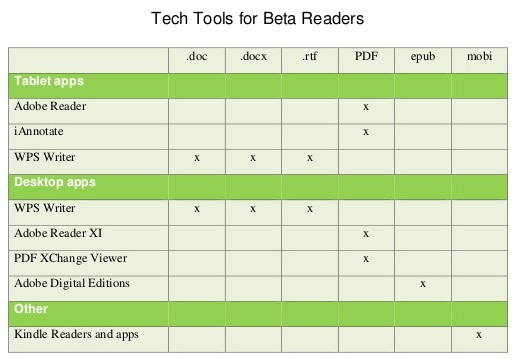By Corina Koch MacLeod and Carla Douglas
Maybe it’s the time of year. All those NaNoWriMo manuscripts are beginning to stir, and they’re popping up like crocuses through the dregs of this winter’s snow.
And what’s on every author’s mind? Beta readers. At Beyond Paper, we’ve been up to our eyebrows in beta readers, too: with two books set to launch soon, we’ve been querying, contacting and attending to the details of this stage of writing.
The result? Our beta readers have obliged in a big way. Now it’s our turn to manage all that great feedback coming our way.
Be Specific
This time last year, we wrote about how to get the most from your beta readers. We suggested that giving beta readers specific things to look for would go a long way to ensuring you get helpful information. In our case, beta readers who’ve offered to read The Ebook Style Guide: Creating Ebooks That Work for Reader have been asked to read for clarity, correctness, and missing topics. (Of course, being editors and proofreaders, our beta readers couldn’t help but flag a few typos and inconsistencies as well—and we thank them for this!)
Know Your Audience
At least one of your beta readers should be a typical reader—someone likely to buy your book. Both of the books we’re about to release are written for a dual audience: self-publishing authors and the editors who work with them. We expect each group will provide unique feedback that will tell us where we need more information or clarity.
Do you write for a dual audience? Maybe you do and you aren’t aware of it. A recent article at The Guardian asks, Why are so many adults reading YA and teen fiction? We won’t subject you to our theories here, but suffice it to say that teens and adults will provide different—but equally helpful—responses to your writing. So, when drawing up a list of potential beta readers, consider who might read your book, then consider who else might read your book.
How Many Beta Readers Do You Need?
In APE: Author, Publisher, Entrepreneur—How to Publish a Book, Guy Kawasaki recounts sending his finished manuscript out to 250 beta readers and receiving approximately 60 of these back, with comments. Whoa! That’s a lot of beta readers, and a lot of beta reader feedback!
Experienced self-publishing authors have their own sense of how many beta readers is enough. We know one author who prefers more—around 15—and divides specific reading tasks among them. Keep in mind that the more beta readers you engage, the more time it will take to sift through their comments. And the larger the crowd of betas is, the more this process is like crowdsourcing. Are beta reading and crowdsourcing the same thing? That’s a discussion for another day, but we’ve touched on it here.
Is More Better?
What’s our ideal number of beta readers? Five. Remember the law of diminishing returns? We’ve found that beyond five readers, feedback becomes repetitive and burdensome in its sheer volume. And when we queried the wise authors on Writer Unboxed about the optimum number of beta readers, the prevailing opinion was the same as ours: between three and five is just about right.
We’d also posit that the more confident you are about your book, the fewer beta readers you need. Asking dozens of readers to weigh in on your work might be construed as saying, “here’s my book, I’m not too sure about it, but tell me what you think anyway,” and then allowing consensus to guide you.
Multiple Formats
Whatever number of beta readers you settle on, make your book available in multiple formats. As we say (repeatedly) at Beyond Paper, it’s all about the reader, and it’s about the beta reader, too. Readers will likely request a format they’re most familiar with to ensure a pleasant reading experience.
Tips: Put file formats in a shared Dropbox folder. Give a deadline.
You have many file formats to choose from, too: Adobe PDF, epub, Google Docs, mobi, Word, and WPS Writer, to name a few. The Slideshare table below features the e-readers and apps available for beta readers and the file formats they’ll read. The accompanying article Tech Tools for Beta Readers goes over each tool’s features.
Receiving Beta Reader Comments
Ideally, beta readers will be familiar with the format they’re using to review your work. It’s critical, too, that they can conveniently transfer comments to you, whether that means copying Kindle notes to a Word doc and emailing them or emailing you a PDF mark-up.
Google Drive presents an interesting option for beta readers, too. If you put your book into a Google doc and share the link, multiple beta readers can add comments in the same document. If you have just a few beta readers, this option is wonderfully convenient, as you have all feedback in one place. Beware, however, that a heavily marked-up document begins to look like a crime scene when too many reviewers weigh in.
Develop a System for Incorporating Feedback
However your beta readers read and however you receive their feedback, you’ll need to record their feedback, decide whether to act on it or discard it, and revise your manuscript (again!) accordingly.
We find a spreadsheet works well for tracking this information:

Wrap Up
If you’ve received enough meaningful feedback to gauge your book’s readiness for the next stage, don’t worry about waiting for all comments to trickle in. If you’ve set a deadline, and if most of your beta readers have been able to meet it (this isn’t always possible), then you should be able to tie up loose ends quickly.
Do remember to thank your beta readers. Send them a free corrected copy of your book, and add them to the acknowledgements. Make a note of those whose feedback you found especially helpful, and be prepared to reciprocate, should the opportunity arise.
 Corina Koch MacLeod and Carla Douglas of Beyond Paper Editing are Contributing Writers for The Book Designer. They are also authors, copyeditors and proofreaders who work with and instruct self-publishing authors.
Corina Koch MacLeod and Carla Douglas of Beyond Paper Editing are Contributing Writers for The Book Designer. They are also authors, copyeditors and proofreaders who work with and instruct self-publishing authors.
You can learn more about Corina and Carla here.
Photo: bigstockphoto.com. Amazon links contain my affiliate code.


